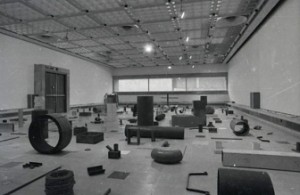Monday November 19th. “UK Industry in Transition”.
Back in London again today.Visited the new display at Tate Modern, “Structure and Clarity”, with stunning works by one of my favourite sculptors Pedro Cabrita Reis and some remarkable constructions in galvanised steel air ducting by Charlotte Posenenske from the 60s. Click on images for full information.


UK Industry in Transition 1966 –79; APG from the Corporation’s Perspective
Monday 19 November, 6.30pm
During the late sixties and seventies the industrial workplace became the site of considerable social/political tension. APG created a framework that enabled artists to question how they could meaningfully intervene in the workplace and in turn, whether or not host organisations (especially large corporations) could view their interventions positively. Through working within Britain’s industrial landscape and initiating discussions with international CEOs throughout the seventies, APG can also claim to have charted Britain’s transition from ‘heavy’ industry (steel manufacture, coal mining, oil and rail) to the third sector (The Department of the Environment and Peterlee Corporation).
This sixth ‘sculpture’ in the series will be moderated by David Hulks and will include Chris Patey (formerly with British Steel Corporation), Peter Byrom (formerly with ICI Fibres Ltd.) and Barbara Steveni.
 This event was remarkable for bringing together Barbara Steveni with 2 of the original industry bosses, including Chris Patey from British Steel, where the 1st APG placement took place. He is featured in one of the archival films in the Raven Row show and a remarkable advocate for APG and their aspirations. I was interested to hear to what extent from the industry perspective the placements fulfilled expectations, and the ‘Incidental Person” experiment worked. The artist, being neither management or shopfloor worker was in a position to bring a fresh vision into the workplace and potentially contribute to and influence decision-making at all levels – as a creative problem-solver. If this had worked it would have been truly revolutionary.The industry bosses seemed ambivalent about its success and there was much discussion about the very different economic and social climate in the late 60s.
This event was remarkable for bringing together Barbara Steveni with 2 of the original industry bosses, including Chris Patey from British Steel, where the 1st APG placement took place. He is featured in one of the archival films in the Raven Row show and a remarkable advocate for APG and their aspirations. I was interested to hear to what extent from the industry perspective the placements fulfilled expectations, and the ‘Incidental Person” experiment worked. The artist, being neither management or shopfloor worker was in a position to bring a fresh vision into the workplace and potentially contribute to and influence decision-making at all levels – as a creative problem-solver. If this had worked it would have been truly revolutionary.The industry bosses seemed ambivalent about its success and there was much discussion about the very different economic and social climate in the late 60s.
I was delighted to meet artist, curator and academic Antony Hudeck, co-curator of the Raven Row exhibition.What became clear to me from our conversation is that using the Archive as inspiration for artistic practice is pretty unique. There’s not been that much done with the Archive anyway, and its mainly been theoretical. Approaching it from a practitioner’s perspective, and then producing a new body of work as a direct result is a new approach which I mus maximise.I am going to propose writing a piece for “Tate Papers”, Tate’s online journal, and approach Barbara Steveni to interview her and make the transcription of our exchange the heart of the article.
